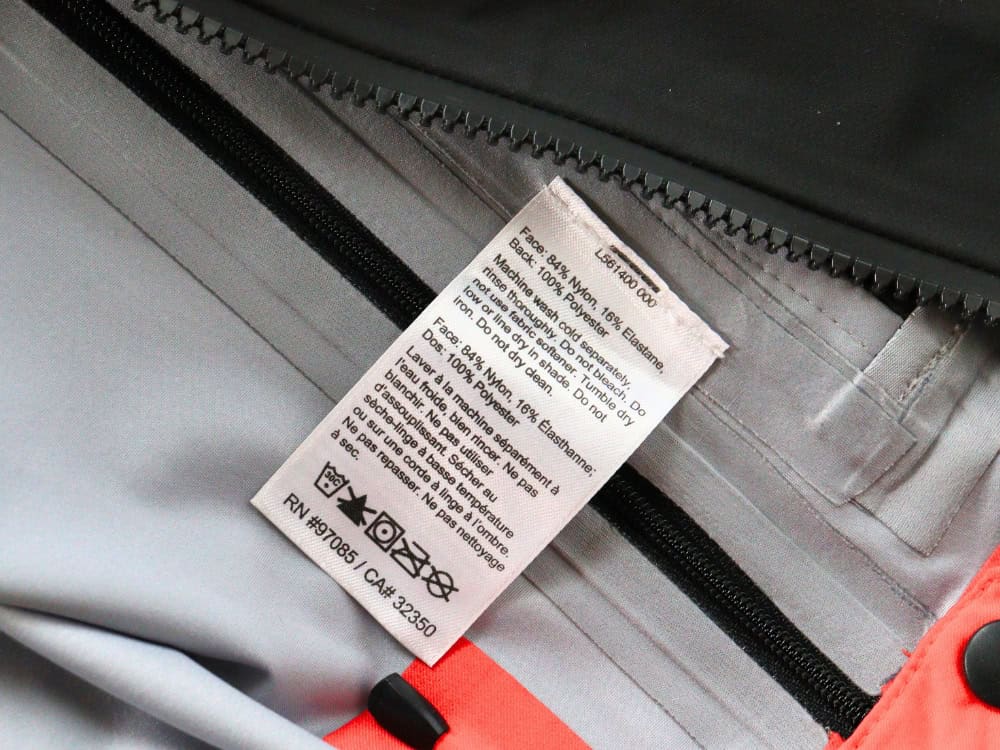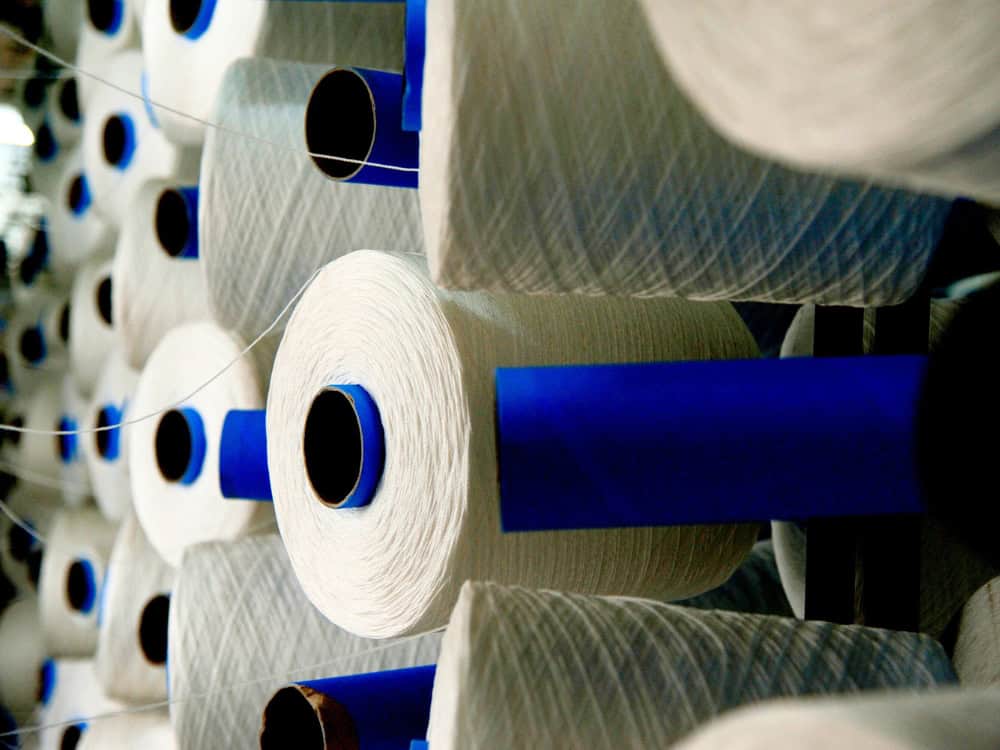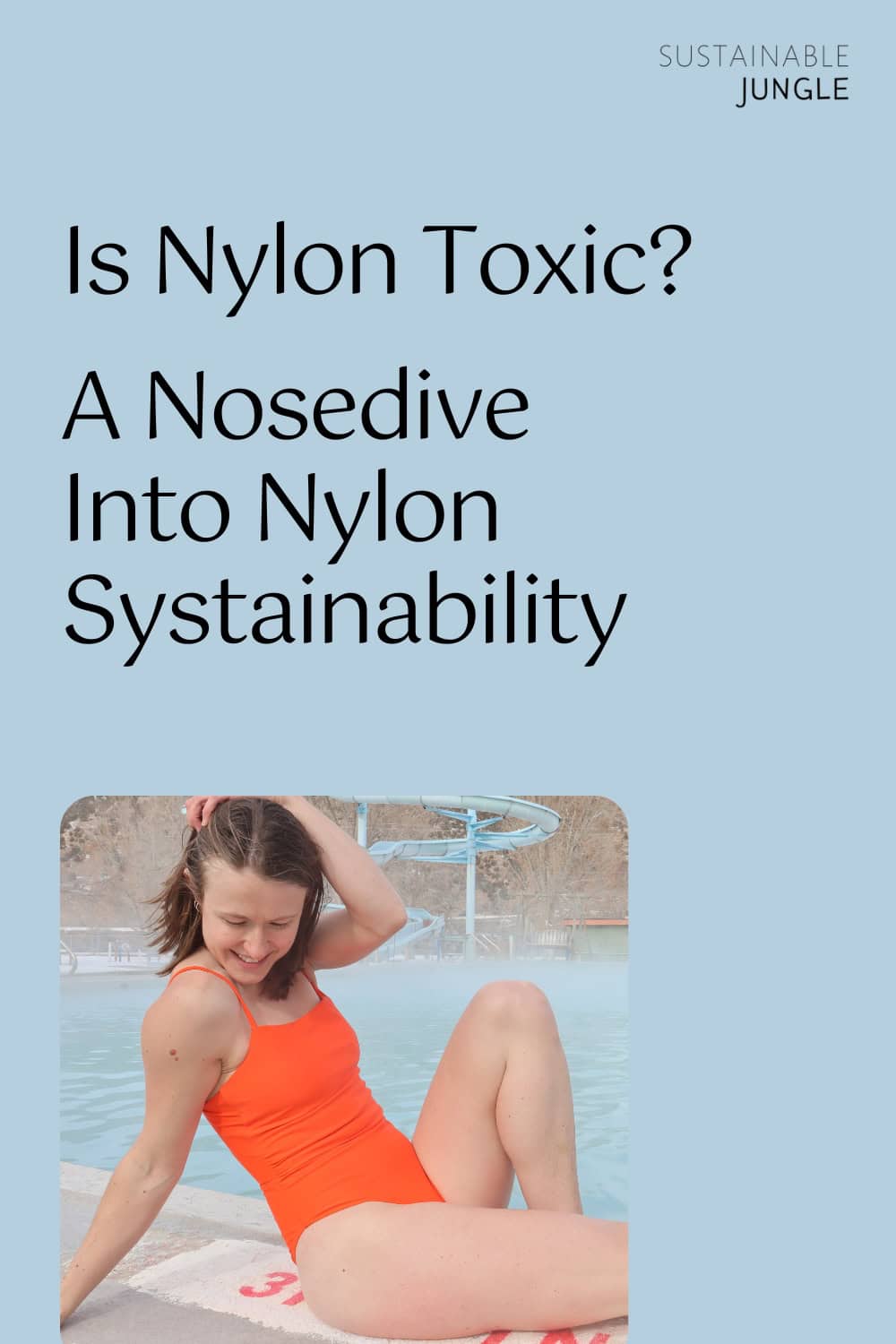
Is Nylon Toxic? A Nosedive Into Nylon Systainability
Take a look at your closet. Roughly one out of every ten garments will have nylon in it (maybe more!).
Around 12% of the world’s synthetic fibers are made from nylon.
Nylon revolutionized the world of synthetic fibers, and while it has made many types of clothes and modern-day essentials possible—like toothbrushes, ropes, carpet, and car parts—that cheap material has come with a heavy cost.
Which brings us to today’s questions: is nylon toxic and eco-friendly?
We’ll cut to the chase and say “no”, so buckle up your nylon seat belt and let’s unravel this so-called ‘miracle fiber‘ and why nylon is bad for the environment and wearers alike.
The Full list Of Nylon Sustainabiltiy Considerations
1. What is Nylon?

Nylon’s first introduction to the world in the early 1930s was met with excitement and celebration.
American chemist Wallace H. Carothers was behin the groundbreaking discovering: the world’s first fully synthetic fiber.
By 1935, nylon was patented, and by 1939, after making its debut at the World’s Fair in New York, it was a fashion world hit— especially as a replacement for silk in women’s hosiery (hence the synonymous terms of “nylons” and “stockings”).
Nylon became so popular because of its versatility and qualities such as being lightweight but durable, easy to wash, resists wrinkles and shrinkage, and dries quickly.
The cost to manufacture the fabric is also relatively low, especially compared with the fabric it was initially designed to replace, so once nylon became a household name, demand skyrocketed.
Touted as having the “strength of steel and the sheerness of cobwebs”, in 1942, the world found yet another new use for nylon fabric: parachutes. Because of World War II, nylon production shifted from women’s stockings to military equipment, like flak jackets, mosquito netting, and even aircraft fuel tanks.
But for all it brought to the world, nylon has a dark side.
2. how Is Nylon Made?

Nylon is a polymer fabric, and like other synthetic fabrics, it’s made from petroleum.
Nylon begins as diamine acid, which is extracted from crude oil and transformed in a process called polymerization—which basically means all the carbon-based molecules (called monomers) are combined in a long chain. The finished product is a polymer (which is why nylon fabric is sometimes known as polyamide), as it contains a long chain of polyamide monomers.
There are a few different types of nylon, but only one is regularly used in fabrics: nylon 6,6. Nylon 6,6 gets its name because the ingredients that synthesize it (adipic acid and hexamethylenediamine) each contain six carbon atoms.
The process used to make nylon fabric looks like this:
- Extracting diamine acid from crude oil (hexamethylenediamine) and combining it with adipic acid to create the polymer, nylon salt.
- Heating, extruding through a metal spinneret, and loading onto a spool.
- Stretching the fibers to give them enhanced strength and elasticity, before wounding them onto another spool for final spinning into fabric.
3. Is Nylon Sustainable?

If you didn’t pick up on this already, nylon isn’t what we consider a sustainable fabric—and this begins with the fact that it’s created using monomers derived from unsustainable fossil fuels.
Petroleum harvesting involves drilling, fracking, or other equally destructive methods that wreak havoc on our environment, before we even get to the chemical, energy, and water-intensive nylon manufacturing process.
It takes 250 MJ of energy to produce 1 KG of nylon—compared to polyester’s 125 MJ and acrylic’s 175 MJ—making it the most energy intensive fabric by a wide margin. So to produce enough nylon to cover one sofa, about 3,886 MJ of energy will be used.
On the chemical side of things, diamine acid has to be combined with adipic acid to make nylon. During the production of adipic acid, significant amounts of nitrous oxide are released into the atmosphere. This greenhouse gas really packs a punch as it’s considered 300 times more harmful than carbon dioxide.
Where it’s made is also of concern. Though originally developed in the US, most nylon manufacturing currently takes place in China, Pakistan, India, and Indonesia, meaning millions of tons of carbon dioxide are produced simply to export this nylon to factories that turn it into goods.
All this before nylon reaches consumer hands.
When those nylon stockings start to run faster than Usain Bolt, they usually end up in landfills—breaking down over the course of hundreds of years—or oceans, as is usually the case with nylon fishing nets, which kill or injure 650,000 marine animals every each.
Even if we take care of our nylon garments to the best of our ability, that doesn’t change the fact that each and every time we wash them, they release microplastics into the environment—to the tune of 900 fibers per garment per wash!—that get eaten by fish and eventually make their way to humans.
4. Is Nylon Clothing Toxic To wear?

We’ve established nylon’s environmental impact is as huge as the fabric’s pervasiveness, but how does it effect wearers?
First and foremost, while it’s commonly found in sportswear, it’s ironically not great for people who like to… well, do sports.
Unlike polyester, its ability to wick moisture is limited—and worse than stewing in your own sweat is stewing in some of the toxic chemicals used to produce those nylon leggings. Think: sulfuric acid, formaldehyde, caustic soda, titanium oxide, and numerous softening agents like limonene, pentene, terpineol, and chloroform.
Suphuric acid has been connected to things like skin irritation to anorexia, while formaldehyde can be emitted from fabrics by body heat (you know, like when you sweat in your activewear), causing skin and eye irritation and long-term carcinogenic effects.
Most concerning is that there has been remarkably little research on the matter, outside a handful of general synthetic fabric toxicity reviews, a look at nylon safety in cosmetics (first of all, ew), and one inhalation toxicity study of nylon respirable fibers in rats, which showed no adverse effects.
So if you’re rolling out your non-toxic yoga mat, skip the nylon fabric clothes for something equally non-toxic.
5. Is Recycled nylon Sustainable?

Recycled nylon fabric—often known by its patented name ECONYL®—is slightly better for our planet.
Unlike traditional nylon made from virgin fossil fuels, recycled or regnerated nylon (as ECONYL® markets it) utilizes nylon that already exists in waste products, namely abandoned fishing nets (AKA ghost nets).
According to Italian plastics company Aquafil who developed the fiber, Econyl has a reduced global warming potential of up to 90% less as compared to standard nylon. Noting that figure has not been independently verified.
However, recycled nylon fabric still faces many of the same setbacks as its virgin counterpart, including not being biodegradable, requiring a similar chemical process as virgin nylon, and often being dyed with materials that may be harmful to workers and the planet.
But we do appreciate the fact that it’s removing harmful discarded fishing nets, both putting them to better use and stopping the demand for more virgin petroleum, and that it bears OEKO-TEX certification for non-toxicity.
Since it’s chemically identical to nylon-6,6, it’s also still stretchy and tough enough to satisfy the performance demands of nylon garments, which is why we see more and more sustainable swimwear brands like Berlook and Outerknown using it.
If shopping from these brands, be aware that even recycled nylon fabric will still produce microplastics upon washing, so always use a Guppyfriend (or other microplastic catching wash bag).
Biodegradable Nylon: Is It Legit?
To be perfectly clear: traditional nylon is NOT biodegradable, no matter what a brand might claim.
But what about newer innovations of the fabric, like CiCLO® technology, which has supposedly created a form of biodegradable nylon by harnessing the power of bioremediative microbes. In other words, “Microbes are attracted to the fibers and can mineralize them at rates comparable to natural fibers.”
If something sounds like greenwashing, it usually is, so we’re still suspect of this new material, but we do recognize that it does have third-party sustainability certifications, including OEKO-TEX® ECO PASSPORT (certifying its ecologically responsible textile manufacturing and non-toxicity to marine life).
It’s also undergone four different biodegradation tests by The American Society for Testing and Materials (ASTM) to demonstrate the exact percentage and timeline in which the fiber breaks down in water, soil, landfill, and sewer sludge.
We’re not sold on CiCLO® nylon just yet, but we are definitely watching sustainable activewear brands like Definite Articles to see how this fiber technology might change the synthetic fabric space for the better.
Did you know we Have a Newsletter?
We cover the latest in sustainable living, fashion, zero waste, beauty, travel, finance and more…
Pin these:





